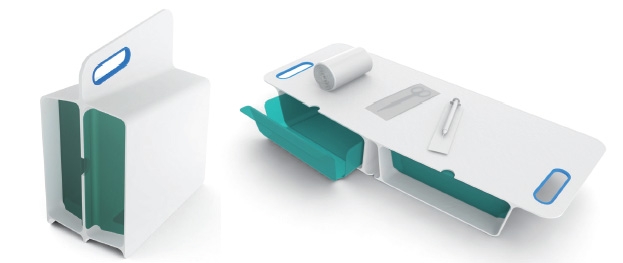Reconciling ergonomics and good design in healthcare

Speakers at the Ergonomics Human Factors Conference will meet next week to discuss how ergonomics and good design practice can be best reconciled, particularly in healthcare.
The Institute of Ergonomics and Human Factors has initiated the conference at Stoke Rochford, near Grantham, Lincolnshire, and says it will look to feature the latest developments in the discipline across all sectors.
One product being touted as an exemplar of good design by the organisation is David Swann’s nursing bag (pictured), set to be delivered at the conference with his paper ’NHS at Home: A co-design research project to develop a 21st century nursing bag’.
Swann is a PhD student at the Royal College of Art and a subject leader for 3D design at the University of Huddersfield, where he lectures.
The bag’s polypropylene moulded case has been designed to reduce the transmission of infection and provide an integrated treatment space and modular drawers.
Principally pitched at community nurses and healthcare workers, the bag will have several advantages, says Swann, who worked with NHS East Riding of Yorkshire and has already established that there is a need, with 68 per cent of ambulance journeys being made to outpatients and a majority of patients preferring to be treated at home. The bag does not replace a standardised product. ’Improvised bags are being used at the moment – even luggage or toolboxes,’ says Swann, who says he has interest from two licensees and is also trying to market the product in the US.
Containing two drawers, the bag is ’an open system’, where one drawer might be used for assessment, with the other reserved for pre-loaded materials put aside with a particular patient in mind, according to Swann.
Standardisation, which is difficult to ensure in the home, is a necessary requirement, Swann feels, so that patients are provided with a constant, especially in neighbourhood nursing, which is constantly changing. ’The bag standardises the treatment and irons out the variables,’ says Swann.
Leading academics and practitioners will be looking at how to further the reconciliation of ergonomic principles and good design practice, particularly in the case of speaker Ken Eason, Professor at Loughborough University’s design school, who is interested in future-proofing ergonomically designed systems by looking beyond user-centred research.
Eason says that although user-centred research is necessary, designers also need to ’gain entry’ to organisations and work with staff to establish their localised needs. Eason also says designers working for healthcare organisations need to safeguard against the changeable nature of the industry.
’The only constant is change,’ says Eason. ’Particularly with the NHS, designers need to deal with that uncertainty – it’s a changeable world and they could be faced with Government action, cuts, anything.’ Eason says that these variables are still unreconciled in the Care Records Service system, which was brought in by the NHS under its £12.4bn National Programme for IT.
A personal key card-activated system, which gives NHS staff varying levels of access to patient information depending on their job, has proved problematic, with staff sharing or borrowing keycards when faced with time-consuming log-in times during emergencies.
Eason says, ’The system is widely abused as staff don’t have a choice. If it were designed from scratch, designers would need to consider every local healthcare setting and look at the particular needs of staff to see how they are going to preserve the content of patient confidentiality.’
Another speaker, Denise Stephens, says that her consultancy, Enabled by Design, is working to identify similar social design challenges, some with ergonomic complications, such as ’How can a mobility scooter hold a child?’
Many healthcare designs fail to balance aesthetics with ergonomic design, says Stephens, who is helping to mediate in the identification of assistive equipment design solutions.
Stephens is now in consultation with the College of Occupational Therapy and universities to see how she can further arbitrate in bringing about the design of assistive equipment.
Enabled by Design, which currently works to stimulate conversation in the field, will evolve, ’So that we can help to adapt existing products in the medium term, and in the long term work with universities and even design consultancies to design new ones,’ says Stephens.
Bag of health benefits
- David Swann’s nursing bag could save healthcare providers up to £1600 per year, he estimates
- This is based on a validity survey revealing increased productivity through modularity, which encourages preparation and saves time
- His target market is the one billion people who receive healthcare treatment away from the traditional hospital
-
Post a comment




